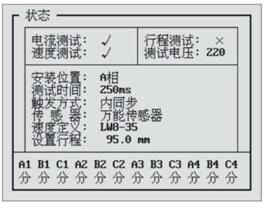1. When the high voltage switch dynamic characteristic tester is grounded on the spot, why should the ground wire be connected first and then the breakout line?
Answer: In the field test, since the high-voltage switch (especially 220Kv or more) often has a high induced voltage between the fractures and the ground, this voltage has a large magnitude and low energy, but it is enough to threaten the safety of the instrument itself. Inside the instrument, there is a bleeder circuit between the fracture signal input end and the ground. The grounding line is first connected, and the bleeder circuit is connected first. In this case, even if the fracture is sensitive to high voltage, it can be discharged to the earth via the bleeder circuit when the signal line is connected to the fracture signal line, thus ensuring the safety of the fracture channel of the instrument.
2. How to determine whether the high-voltage switch dynamic characteristics tester port is normal?
A: Select the test-closing test, and the real-time status display of 12 fractures at the bottom of the LCD display of the high-voltage switch dynamic characteristics tester. The screen shows the following picture:

In this interface, it is possible to detect whether the fracture channel of the high-voltage switch dynamic characteristics tester is intact. If the fracture input is vacant, “minute†should be displayed. If the ground fault occurs, “close†should be displayed. Therefore, short-circuit the respective fractures to the ground and observe the changes in the status display to determine whether the fracture time channel of the instrument is normal.
3. What is the speed of splitting (combining)? What is the difference between the time division and the distance segment to define the speed of the switch?
A: The so-called “separate†speed refers to the average speed of a high-voltage switch (just before the point of time) after a period of time (or a certain distance). If the time is the defining standard, the IEC standard and the national standard of China are generally defined as the average speed of 10 ms after the previous split. For the different definitions of some countries or some switch manufacturers, our company's equipment can be redefined through the definition of computer and matching speed. It can be defined as either a time zone or a distance segment, which provides a flexible and convenient speed test for high voltage switches. Taking a vacuum switch as an example, the opening distance of a 10KV switch is generally about S=11mm, and the rigid-joint (minute) speed is defined as the average speed of 6mm before and after rigid-jointing. Some manufacturers also define the following types:
a) Take the whole process of closing and take the average speed of 6mm after the sub-gate is taken;
b) Take the whole course of closing and take the average speed of the whole journey.
With the speed definition add program function, it is also convenient to perform speed test according to the specific vacuum switch. In addition, when the vacuum switch is tested for speed, the average speed of the entire opening process is very low due to the effect of the buffer mechanism during the opening. Generally defined as the average speed of the buffering mechanism during the opening and closing of the vacuum switch is the average speed of the entire process, that is, the closing takes the whole process average, and the average speed of 6 mm after the opening and closing is divided is close to the real value. Since the 35KV vacuum switch opening distance is generally about S=22mm, the value 6 in the above definition for the 10KV vacuum switch speed can be changed to 10 or 11.
Ductile Iron Sand Castings,Sand Casting,Malleable Cast Iron Sand Casting Product,Cast Iron Sand Casting
Hebei Chunfeng International Trade Co., Ltd , https://www.chunfengenergy.com